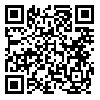Volume 17, Issue 4 (Vol.17, No.4, Winter 2022 2022)
irje 2022, 17(4): 311-319 |
Back to browse issues page
Download citation:
BibTeX | RIS | EndNote | Medlars | ProCite | Reference Manager | RefWorks
Send citation to:



BibTeX | RIS | EndNote | Medlars | ProCite | Reference Manager | RefWorks
Send citation to:
Maroofi P, Cheraghi Z, Tapak L. Investigation of Epidemiological Features of Measles Outbreaks in the World in 2018. irje 2022; 17 (4) :311-319
URL: http://irje.tums.ac.ir/article-1-7131-en.html
URL: http://irje.tums.ac.ir/article-1-7131-en.html
1- MSc Student, Department of Epidemiology, School of Public Health, Hamadan University of Medical Sciences, Hamadan, Iran
2- Assistant Professor, Research Center for Health Sciences, Hamadan University of Medical Sciences, Hamadan, Iran
3- Assistant Professor, Department of Biostatistics, School of Public Health, Hamadan University of Medical Sciences, Hamadan, Iran
2- Assistant Professor, Research Center for Health Sciences, Hamadan University of Medical Sciences, Hamadan, Iran
3- Assistant Professor, Department of Biostatistics, School of Public Health, Hamadan University of Medical Sciences, Hamadan, Iran
Abstract: (987 Views)
Introduction: Identifying the epidemiological features of reported measles outbreaks including the size, period, and generation of the outbreaks plays a significant role in preventing new outbreaks and estimating effective reproduction number (R) as an indication of measles elimination. This study was conducted to describe the reported measles outbreaks in the world in 2018.
Method: The PubMed, Scopus, and Web of Sciences databases were searched using related keywords to retrieve articles that reported 2018 measles outbreaks. From the full-texts of the articles that met the inclusion criteria, the data including gender, season, age group, country, genotype, and vaccination status as well as shape, size, period of outbreaks and number of generations of each outbreak were extracted and reported using the relevant epidemiological curves.
Results: The search results led to the retrieval of 2806 articles. After screening, 16 studies were used for final analysis. Most outbreaks were reported in the winter (56.25%) with genotypes B3 and D8. The sex female (38.64%, 308 cases) was mostly in Asia and Europe. On average, the minimum and maximum number of outbreaks size was 1 and 23, which spread to 3-4 generations. In terms of death, only one case of death was reported in Ethiopia.
Conclusion: The results of this study are useful for identifying measles outbreaks in other countries according to the at-risk groups. However, publication bias and non-reporting of all outbreaks should be considered as limitations in the generalization of the results.
Method: The PubMed, Scopus, and Web of Sciences databases were searched using related keywords to retrieve articles that reported 2018 measles outbreaks. From the full-texts of the articles that met the inclusion criteria, the data including gender, season, age group, country, genotype, and vaccination status as well as shape, size, period of outbreaks and number of generations of each outbreak were extracted and reported using the relevant epidemiological curves.
Results: The search results led to the retrieval of 2806 articles. After screening, 16 studies were used for final analysis. Most outbreaks were reported in the winter (56.25%) with genotypes B3 and D8. The sex female (38.64%, 308 cases) was mostly in Asia and Europe. On average, the minimum and maximum number of outbreaks size was 1 and 23, which spread to 3-4 generations. In terms of death, only one case of death was reported in Ethiopia.
Conclusion: The results of this study are useful for identifying measles outbreaks in other countries according to the at-risk groups. However, publication bias and non-reporting of all outbreaks should be considered as limitations in the generalization of the results.
Type of Study: Research |
Subject:
Epidemiology
Received: 2022/07/31 | Accepted: 2022/03/22 | Published: 2022/03/22
Received: 2022/07/31 | Accepted: 2022/03/22 | Published: 2022/03/22
| Rights and permissions | |
 |
This work is licensed under a Creative Commons Attribution-NonCommercial 4.0 International License. |





